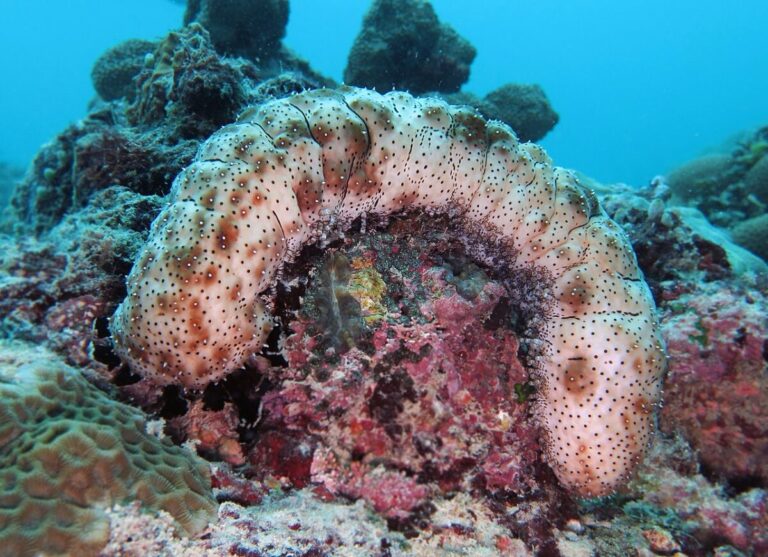Scientists in China have conducted an annual study into six “Aquavoltaics” farms that organize the aquacultures of Zeekomkommer under the solar panels. Due to the lower water temperature, the animal’s winter wacker period was reduced, as well as the death, compared to the previous year.
Researchers from China conducted research for a year into the impact of PV farms on the aquaculture of the Zeekomkommer.
With the help of the statistical technology of the Structural Comparison (SEM), the group collected information from six comparable ponds that were used for the commercial growth of the Apostichopus japonicus sea cucumor species. Three of them, called PVP, were partially covered with PV panels (PVP), while the other three were not covered at all and NPVP were labeled.
“As an important economic species in the world, sea cucumbers have high nutritional and medicinal values, which are often scarce on the consumer market,” the researchers explained. “By installing PV arroys above and cultivated sea cucumbers below, this integration can tackle some of the problems in sea cucumbers pond aquaculture: the shadow effect of the PV panels will lower the water temperature in the ponds, allowing them to grow in the Sea cucumbers in summer high temperature death; And the cooling from Shadow can shorten the estration duration of sea cucumbers. “
The integration of solar energy with aquaculture is often called ‘aquavoltaic’. The Aquavoltaic station where the research was done is located in the east of China, in the Yellow River Delta. It included approximately 4.28 km², with 40.0% of the pond area covered by PV. The station has a total capacity of 200 MW, where the PV modules are placed with an azimut corner of 0ender and a tilt corner is 37Z. The panel height relative to the water changes with the season, but at no time it is less than 1.5 meters.
Each of the six ponds studied had an area of approximately 6.7 hm2, with an average water depth of 1.5 m. Monitoring took place between March 2023 and February 2024, with the help of different sensors. In addition, water samples were taken from three random locations located along the diagonal of each pond. A sample of three to five people from sea cucumbers was randomly chosen from every pond, weighed, dissected and stored at -80 C.
“SEMs were constructed using the pieces of SEM package in R. Initially, correlations between all parameters were analyzed to assume the paths of interaction between parameters for model design and optimization,” the academics explained. “The final optimized model, which included most variables and significant paths (p <0.05), with the lowest akaike Information Criterion (AIC) scores, was assessed for goodness of Fit using chikwadraat statistics.
According to the research results, the PV coverage had considerably reduced the light intensity and water temperature. Compared to the NPVPA, the light intensity in shaded areas of the PVPs was reduced by 80.5%, resulting in a decrease of 1.20 ° C in water temperature. The duration of the estivation – a state of hibernation that the sea cucumbers undergo when the water temperatures become too high – was also lowered in the PVP. In sub-adult sea cucumbers it was reduced by 12 days and in adults by one day.
“Sea cucumbers provide data from 2023 on a higher productivity in the PVP group (900 kg/hm²) compared to the NPVP group (750 kg/hm²), based on Boerecord,” the academics added. “However, the data was from external records and were not immediately monitored by us, so their accuracy and validity cannot be fully guaranteed.”
Moreover, the analysis showed that PV integration had no negative influence on other physical and chemical parameters, plankton composition or sea cucumber physiology. “The seasonal increase in pyrophophyta and the reduced abundance in zooplankton emphasize the need for continuous ecological monitoring to prevent possible step -by -step effects on ecosystem stability and aquaculture productivity,” they emphasized.
Their findings were presented in “Potovoltaic Integration with Sea Cucumber Aquaculture: Environmental effects and Holothurian digestion and Estivation“Published in Aquaculture reports. Researchers from the Chinese Chinese Academy of Sciences, the Qingdao Marine Science and Technology Center, Ludong University and Yantai University have conducted the study.
This content is protected by copyright and may not be reused. If you want to work with us and reuse part of our content, please contact: editors@pv-magazine.com.


